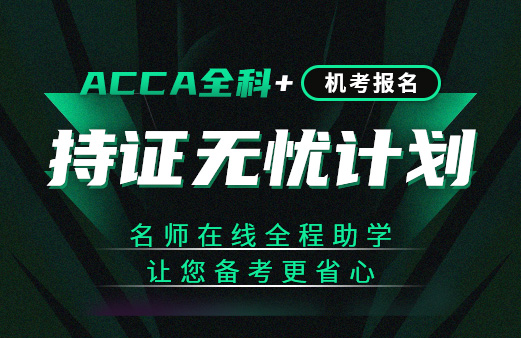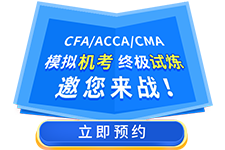真题练习是学员必须要做的,一是为了了解ACCA考试的题型有哪些,二是为了查看考试的知识点内容有哪些。ACCA PM历年真题练习!
The Chemical Free Clean Co (C Co) provides a range of environmentally-friendly cleaning services to business customers, often providing a specific service to meet a client’s needs. Its customers range from large offices and factories to specialist care wards at hospitals, where specialist cleaning equipment must be used and regulations adhered to. C Co offers both regular cleaning contracts and contracts for one-off jobs. For example, its latest client was a chain of restaurants which employed them to provide an extensive clean of all their business premises after an outbreak of food poisoning.
The cleaning market is very competitive, although there are only a small number of companies providing a chemical free service. C Co has always used cost-plus pricing to determine the prices which it charges to its customers but recently, the cost of the cleaning products C Co uses has increased. This has meant that C Co has had to increase its prices, resulting in the loss of several regular customers to competing service providers.
The finance director at C Co has heard about target costing and is considering whether it could be useful at C Co.
Required:
(a) Briefly describe the main steps involved in deriving a target cost. (3 marks)
(b) Explain any difficulties which may be encountered and any benefits which may arise when implementing
target costing at C Co. (7 marks)

Answer:
(a) Target costing steps
Deriving a target cost
Step 1: A product or service is developed which is perceived to be needed by customers and therefore will attract adequate sales volumes.
Step 2: A target price is then set based on the customers’ perceived value of the product. This will therefore be a market based price.
Step 3: The required target operating profit per unit is then calculated. This may be based on either return on sales or return on investment.
Step 4: The target cost is derived by subtracting the target profit from the target price.
Step 5: If there is a cost gap, attempts will be made to close the gap. Techniques such as value engineering may be performed, which looks at every aspect of the value chain business functions with an objective of reducing costs while satisfying customer needs.
Step 6: Negotiation with customers may take place before deciding whether to go ahead with the project.
(b) Application at C Co
Difficulties in implementation
– C Co is a service company and in service companies, it is often more difficult to find a precise definition for some of the services. In order for target costing to be useful, it is necessary to define the service being provided. C Co actually provides a range of services to clients including specialist care wards at hospitals. This means that the definition of the services being provided will vary. Different target costs will need to be derived for the different services provided.
– C Co has two types of clients: regular clients and one-off clients. Since the service for regular clients is being repeated,it should be relatively easy to set a target cost for these jobs. However, for the one-off jobs, there may not be any comparative data available and therefore setting the target cost will be difficult.
– Similarly, some of the work available is very specialist. For example, cleaning restaurants and kitchens after an outbreak of food poisoning will require specialist techniques and adherence to a set of regulations with which C Co may not be familiar. It may be difficult to establish the market price for a service like this, thus making it difficult to derive a target cost.
Benefits to C Co
– Target costing is useful in competitive markets where a company is not dominant in the market and therefore has to accept a market price for their products. C Co is operating in a competitive market and whilst the service offered by C Co is more specialist, it is clear from the recent drop in sales that price increases do lead to loss of customers. C Co cannot therefore ignore the market price for cleaning services and simply pass on cost increases as it has done. Target costing would therefore help C Co to focus on the market price of similar services provided by competitors, where this information is available.
– If after calculating a target cost C Co finds that a cost gap exists, it will then be forced to examine its internal processes and costs more closely. It should establish why the prices of the products it uses have increased in the first place. If it cannot achieve any reduction in these prices, it should consider whether it can source cheaper non-chemical products from alternative suppliers. So, target costing will benefit C Co by helping it to focus on cost reduction and consequently customer retention.
Note: More points could be made and would earn marks.
- 报考条件
- 报名时间
- 报名费用
- 考试科目
- 考试时间
-
GARP对于FRM报考条件的规定:
What qualifications do I need to register for the FRM Program?
There are no educational or professional prerequisites needed toregister.
翻译为:报名FRM考试没有任何学历或专业的先决条件。
可以理解为,报名FRM考试没有任何的学历和专业的要求,只要是你想考,都可以报名的。查看完整内容 -
2024年5月FRM考试报名时间为:
早鸟价报名阶段:2023年12月1日-2024年1月31日。
标准价报名阶段:2024年2月1日-2024年3月31日。2024年8月FRM考试报名时间为:
早鸟价报名阶段:2024年3月1日-2024年4月30日。
标准价报名阶段:2024年5月1日-2024年6月30日。2024年11月FRM考试报名时间为:
早鸟价报名时间:2024年5月1日-2024年7月31日。
标准价报名时间:2024年8月1日-2024年9月30日。查看完整内容 -
2023年GARP协会对FRM的各级考试报名的费用作出了修改:将原先早报阶段考试费从$550上涨至$600,标准阶段考试费从$750上涨至$800。费用分为:
注册费:$ 400 USD;
考试费:$ 600 USD(第一阶段)or $ 800 USD(第二阶段);
场地费:$ 40 USD(大陆考生每次参加FRM考试都需缴纳场地费);
数据费:$ 10 USD(只收取一次);
首次注册的考生费用为(注册费 + 考试费 + 场地费 + 数据费)= $1050 or $1250 USD。
非首次注册的考生费用为(考试费 + 场地费) = $640 or $840 USD。查看完整内容 -
FRM考试共两级,FRM一级四门科目,FRM二级六门科目;具体科目及占比如下:
FRM一级(共四门科目)
1、Foundations of Risk Management风险管理基础(大约占20%)
2、Quantitative Analysis数量分析(大约占20%)
3、Valuation and Risk Models估值与风险建模(大约占30%)
4、Financial Markets and Products金融市场与金融产品(大约占30%)
FRM二级(共六门科目)
1、Market Risk Measurement and Management市场风险管理与测量(大约占20%)
2、Credit Risk Measurement and Management信用风险管理与测量(大约占20%)
3、Operational and Integrated Risk Management操作及综合风险管理(大约占20%)
4、Liquidity and Treasury Risk Measurement and Management 流动性风险管理(大约占15%)
5、Risk Management and Investment Management投资风险管理(大约占15%)
6、Current Issues in Financial Markets金融市场前沿话题(大约占10%)查看完整内容 -
2024年FRM考试时间安排如下:
FRM一级考试:
2024年5月4日-5月17日;
2024年8月3日(周六)上午;
2024年11月2日-11月15日。FRM二级考试:
2024年5月18日-5月24日;
2024年8月3月(周六)下午;
2024年11月16日-11月22日。查看完整内容
-
中文名
金融风险管理师
-
持证人数
25000(中国)
-
外文名
FRM(Financial Risk Manager)
-
考试等级
FRM考试共分为两级考试
-
考试时间
5月、8月、11月
-
报名时间
5月考试(12月1日-3月31日)
8月考试(3月1日-6月30日)
11月考试(5月1日-9月30日)








